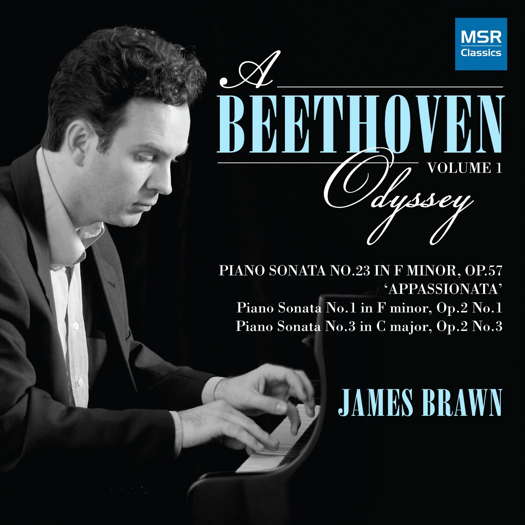 SPONSORED: CD Spotlight. Masterfully Controlled - James Brawn's Beethoven Odyssey impresses Andrew Schartmann.
SPONSORED: CD Spotlight. Masterfully Controlled - James Brawn's Beethoven Odyssey impresses Andrew Schartmann.
All sponsored features >>

Fascinating and Powerful
GERALD FENECH highly recommends Marc-André Hamelin's recent Hyperion recording of Beethoven's Hammerklavier Sonata
'... inspirational performances overflowing with arresting pianism.'
There are a myriad recordings dedicated to Ludwig van Beethoven's piano sonatas, whether as couplings or in complete cycles. Many are very memorable regarding performance and presentation, but every now and then there comes along an issue that rouses a certain amount of interest for some reason or other. This disc is such a case. Why? Because the programme includes the composer's very early sonata No 3 in C, Op 2, and the monstrous Hammerklavier No 29 in B flat, Op 106, which Beethoven composed in the very last year of his life.
More than a year in the making, the Hammerklavier was the most ambitious - and by some degree the longest - piano sonata Beethoven had ever composed. It was written between 1817 and 1818 and has a duration of some forty-five minutes. Unlike the Moonlight and Appassionata Sonatas, the conventional subtitle offers no clues as to the music's distinctive character. In what seems to have been a burst of patriotic feeling, Beethoven insisted that the Sonata should be advertised as written for the 'Hammerklavier', the German word for 'pianoforte'. The sonata was radically unconventional, and was described as a sort of inauguration to a new style in Beethoven's keyboard works. Uncertain of how his creation would be received, he encouraged his British publisher to issue the score in two separate volumes.
Beethoven signals his intention of working on an outsized scale at the outset. No sooner have a pair of mighty chordal thunderclaps fixed the listener's attention then he switches abruptly to a lighter, more transparent lyrical mode. Sharp dynamic contrasts, sudden shifts of register and texture and bold juxtapositions of keys are the very essence of the opening Allegro.
Listen — Beethoven: Allegro (Hammerklavier Sonata)
(CDA68456 track 1, 0:03-0:56) ℗ 2024 Hyperion Records Ltd :
The short Scherzo, with its springy, tautly wound theme and ominously roiling midsection, reinforces the sense of dynamic instability that pervades the sonata.
The heart of the work is the richly introspective Adagio sostenuto, whose transcendent spirituality points the way towards Beethoven's last piano sonatas and string quartets.
Listen — Beethoven: Adagio sostenuto (Hammerklavier Sonata)
(CDA68456 track 3, 12:40-13:37) ℗ 2024 Hyperion Records Ltd :
The finale begins with a series of sustained thrills that launch an energetic three-voice fugue. Midway through the movement, Beethoven pauses to introduce a placid second subject in quarter notes, which he proceeds to interweave with the first subject in a final dazzling double fugue.
Listen — Beethoven: Allegro risoluto (Hammerklavier Sonata)
(CDA68456 track 4, 8:53-9:48) ℗ 2024 Hyperion Records Ltd :
The Piano Sonata No 3 in C, Op 2, was written in 1795 and dedicated to Joseph Haydn. This work is often referred to as one of Beethoven's earliest 'grand and virtuosic' piano sonatas. All three of the composer's Op 2 contain four movements, an unusual length at the time, which shows that Beethoven was probably planning to write a symphony. It is both the weightiest and the longest of the three Op 2 sonatas, and it presents many difficulties for the performer, including difficult trills, awkward hand movement and forearm rotation. At 24-26 minutes in length, it is only second to the Grand Sonata in E, Op 7, which like the No 3 in C, Op 2, was published in 1796.
Listen — Beethoven: Allegro assai (Piano Sonata in C, Op 2 No 3)
(CDA68456 track 8, 4:33-5:28) ℗ 2024 Hyperion Records Ltd :
Marc-André Hamelin is one of the finest pianists around. Renowned for his musical insight and technical wizardry, Hamelin never resorts to unnecessary showmanship or emotional ambiguity; indeed, he possesses a deep sense of obedience to the composer's score, playing every note with unmitigated precision and fastidious attention to tempo markings. Fascinating and powerful Beethoven in inspirational performances overflowing with arresting pianism. Highly recommended.
Copyright © 4 November 2024
Gerald Fenech,
Gzira, Malta





